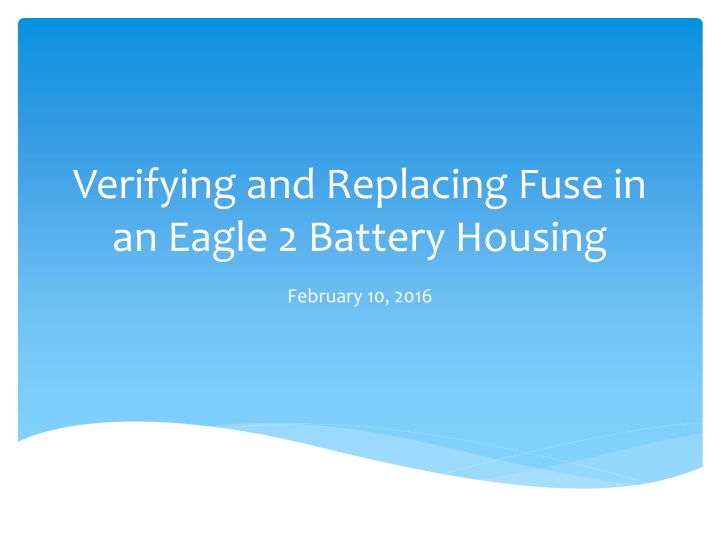
How to Verify and Replace Fuse in Eagle 2 Battery Housing
Learn how to verify and replace a fuse in an Eagle 2 battery housing. Follow step-by-step instructions including removing the pack, testing the fuse, and replacing it if necessary. Use images and tools like soldering iron, solder, multimeter, and more for a successful repair.
Download Presentation

Please find below an Image/Link to download the presentation.
The content on the website is provided AS IS for your information and personal use only. It may not be sold, licensed, or shared on other websites without obtaining consent from the author. If you encounter any issues during the download, it is possible that the publisher has removed the file from their server.
You are allowed to download the files provided on this website for personal or commercial use, subject to the condition that they are used lawfully. All files are the property of their respective owners.
The content on the website is provided AS IS for your information and personal use only. It may not be sold, licensed, or shared on other websites without obtaining consent from the author.
E N D
Presentation Transcript
Verifying and Replacing Fuse in an Eagle 2 Battery Housing February 10, 2016
Parts Required Soldering iron Solder Solder braid Small Vice Fuse P/N 43-4142RK-10 Digital Multimeter with quick hook clip leads
Remove pack and batteries from Eagle 2
Setup to Test Fuse Need DMM set to measure diode function
Measuring Points Measuring three diodes through the 1.5 A fuse in the battery housing. CN1 on left and EC 1 or EC 2 on right.
Open Fuse Place DMM into Diode Checking Mode. Attach positive DMM lead to CN1 lead, and attach or touch black DMM lead to EC1 or EC2. If OL is displayed, fuse is open.
Good Fuse If the fuse is good, you will see the diode drop across the three Schottky Diodes, Fuse F1 and BC1 which is connected to EC1 and EC2.
Reverse leads to check diodes in box with good fuse
Using a Phillips screwdriver, remove the two screws that connect the PCB to housing.
Plug in charger cable to use as a heat sink. Do not plug the charger into power outlet!
Carefully remove solder from charger socket. Solder braid works well here.
Remove thermistor from housing. Note, make sure thermistor is reinstalled after fuse replacement
Using soldering iron, heat side of fuse and lift from PCB. Do this to both sides and remove the fuse.
Once fuse is removed. Clean old solder from pads and add small amount of fresh solder
Reattach charger socket to PCB. Keep charger plug in connector. Remove charger plug when completed.
Replace batteries and verify that battery pack charges.
Charge Module Plug charger into AC outlet Green LED will illuminate, then Yellow LED then both Green and Yellow LEDs will remain lit. This is what you see when the charger boots up. Plug charger cord into Eagle 2 battery pack The Green LED will go out and the Yellow will remain lit. If not, then there is no charging current flowing into batteries. Further investigation is required.






















